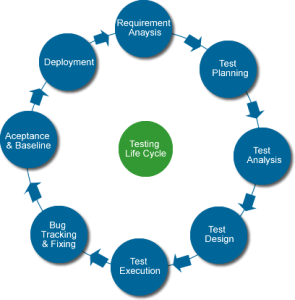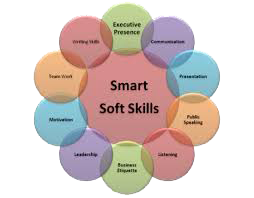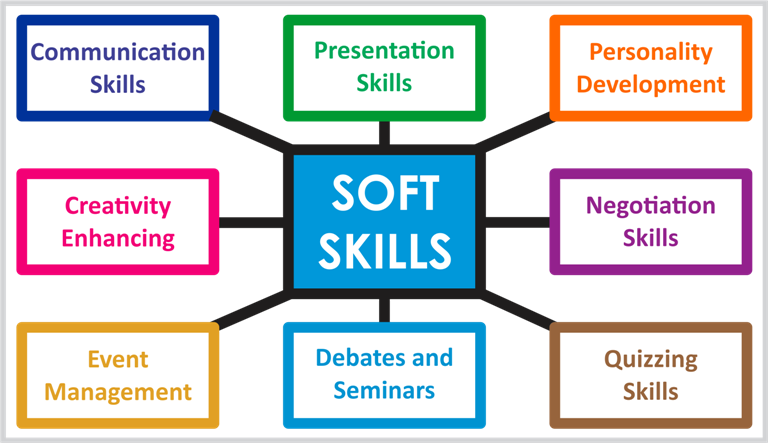 |
 |
Friday, June 03, 2016 Share this Article |

|
Essential Skills To Become A Great UI/UX Designer 
It’s frustrating to find job offers looking for a UI/UX designer. While these two skillsets are closely related, their skills don’t always overlap. A quality UI designer may not understand user experience psychology. Just like a top-tier UX designer might not be a master of Photoshop or Sketch. |
Software Testing - Bug Life Cycles 
Software testing involves the implementation of a number of specific cyclic routines and procedures. In this Buzzle article, we examine the various life cycles that a bug passes through during a software testing process.The duration or time span from the moment that a bug is discovered till it is closed successfully.
|
|||
|
||||
|
Six Business Skills Every New Graduate Needs to Develop

If you think you have nothing left to learn after all the books you cracked in college, think again. There’s a whole set of business skills you probably weren’t taught in class, even if you were a business major. So as a new graduate, be sure to brush up on these six essential job skills you’ll need to succeed in the workforce. |
The Five Biggest Problems In Health Care Today

I named this blog “Losing Patients” as a play on words. But in all seriousness, our health care system is literally losing “patients,” killing more than 500 per day from errors, accidents and infections in hospitals alone, not to mention the mortality and suffering from millions of procedures that never needed to be done in the first place. |
|||
|
Detailed Articles |
||||
|
Essential Skills To Become A Great UI/UX Designer 
It’s frustrating to find job offers looking for a UI/UX designer. While these two skillsets are closely related, their skills don’t always overlap. A quality UI designer may not understand user experience psychology. Just like a top-tier UX designer might not be a master of Photoshop or Sketch. But there is a good amount of overlap, and to be a great UI/UX designer you’ll need to dip a toe into both worlds. In this guide I want to comb over the fundamental skills that you should learn to promote yourself as a quality UI and/or UX designer. Job security is much easier when you can alternate between both roles. And it’ll be easier for you to see the big picture in any creative project. User AdvocationRemember that a UI/UX designer speaks for the user. But you are not the user. This is an important distinction because most people using your product will not have the same expertise. This is why usability testing can be so important. Ask users directly what they like and don’t like. Gather feedback. Try to find the root cause of their issues and make only the necessary changes. Every great UX designer will be a true advocate for the user. The user experience goes beyond a glossy interface to encompass how the UI feels, behaves, and responds to user interaction. Pay careful attention to the details and be willing to scrap ideas even if you think they’re great. In a situation where you like something that most users don’t it’s generally wise to drop the idea and rework it a little. Listen to the user’s complaints and try to understand what they’re really saying. This is true of both UX and UI designers, although most user testing involves the UX side of things. A pretty interface means jack if it can’t operate properly. Advocate for the user through your words and actions. This is ultimately the #1 requirement of a UX designer. It’s a tough skill to nail down because it’s not exactly a specific skill. But I’d say having an open mind and being willing to rethink ideas will help you understand the user’s perspective much easier. Visual CommunicationPerhaps the most valuable skill of any designer is visual communication. Most designers get ideas in their head and need to explain these ideas to project managers, developers, or other designers. Being able to sketch is a great skill to have for this very reason. But you can also communicate ideas digitally by creating digital wireframes, mockups, or interactive prototypes.The tool or medium you use to create visual assets really doesn’t matter. Naturally it’s great to have many tools in your toolbox. But if you don’t know Photoshop and only use wireframing tools this can work fine. It’s very important to communicate your ideas visually to the design team & the development team. It’s possible to do this with words but you’ll have a much easier time showing rather than telling. Be able to communicate with business and marketing guys too. This means using layman’s terms to explain more complicated features. Explain what the UX plan is to everyone using whatever visuals or words necessary. One part of this is to master a visual medium(whether sketching or software). The other part of this is communication. Just because an idea makes sense to you doesn’t mean it’s being explained properly to make sense to others. Ask your team and clients if they need clarification on anything. Don’t let anyone sit there nodding too afraid to speak up and ask questions. Soft skills are vital to UX work. Learn to love communication and your job will be that much easier! Digital Design SoftwareNot all UX designers know how to use Photoshop, Sketch, or Illustrator. But every UI designer should know at least one of these programs.The differences between these two jobs are small but noticeable. UI designers must create visuals whether icons, logos, or interface mockups. UX designers are more concerned with how these interfaces behave and how users complete their objectives. But if you’re going the UX design route it’s still wise to study Photoshop or Sketch(or both). Just mastering one of these programs will help you express your visual ideas much clearer. You’ll also be much more lucrative to employers. And with so many online tools it’s important to branch out when needed. Desktop software like the Adobe suite is crucial to the design process. But UI/UX platforms like InVision and UXPin can both prove vital to your portfolio of skills. These are tools for rapid prototyping and creating interactive demos from scratch.You can accomplish this same task with a frontend library like Bootstrap, but not all UX designers want to learn coding. Truthfully it doesn’t matter how you create prototypes. But if you have a broad range of skills using various design programs your resume will be much more lucrative. One last tool I’d recommend learning is a digital UX animation program. The two most popular choices are Principle and Adobe After Effects. These programs let you import digital mockups and manipulate the layers to create custom animations.Check out this TutsPlus tutorial if you want to learn more. It’s not easy picking up all these programs but you’ll be thanking yourself later. A great UI/UX designer should be thinking about every step of the design process. It starts with wireframing and prototyping, then moves through digital graphic/UI design into full interactivity. These animation programs allow you to simulate interactivity without actually building a demo interface with code. Project leaders like to see these kinds of assets and your skills will prove invaluable to the process. Article Source |
||||
|
Software Testing - Bug Life Cycles 
Software testing involves the implementation of a number of specific cyclic routines and procedures. In this Buzzle article, we examine the various life cycles that a bug passes through during a software testing process.
The duration or time span from the moment that a bug is discovered (status: 'New') till it is closed successfully, rejected, postponed or deferred is called 'Bug/Error Life Cycle'.
Right from the first time any bug is detected till the point when the bug is fixed and closed, it is assigned various statuses which are New, Open, Postpone, Pending Retest, Retest, Pending Reject, Reject, Deferred, and Closed.
Cycle I
Cycle II
Cycle III
Cycle IV
Cycle V
Cycle VIAfter confirmation that the data is unavailable or certain functionality is unavailable, the solution and retest of the bug is postponed for indefinite time and it is marked as 'Postponed'. Cycle VIIIf the bug does not stand importance and needs to be postponed, then it is given a status as 'Deferred'. Article Source |
||||
|
Coin change 
Itech Solutions has bagged an opportunity to develop a Real Time Trading of Bitcoins and Ether application for Coin change. The purpose is to A Bitcoin/Ether wallet and exchange providing real time trading of Bitcoin, Ether and INR and operating at the highest levels of security and reliability. Benefits of Coinchange are REAL TIME TRADING, YOUR OWN INR BITCOIN WALLET, REGULATORY EXPERTS and EXPRESS INR WITHDRAWALS AND DEPOSITS etc.. This Project Developed as a web application on J2EE technologies, which is a time based and reliable option for Trading Solutions. It provides admin to keep track the details of Traders as well as Clients. Admin can easily generate the excel reports. Reports save huge amount of time and enable the department faculty to take effective and quick decisions about clients and the various trade sectors. The major module includes: Register, Login, Various Reports, Trading of Bit coins and Ethers, end to end data handling for various reports. The Real Time Trading application will help the clients to better manage the Trading, closely monitor their progress and Real time with express deposits and withdrawals. The ERP application will help the department to better manage the students, closely monitor their progress and deliver value to the teaching activities. |
||||
Six Business Skills Every New Graduate Needs to Develop 
If you think you have nothing left to learn after all the books you cracked in college, think again. There’s a whole set of business skills you probably weren’t taught in class, even if you were a business major. So as a new graduate, be sure to brush up on these six essential job skills you’ll need to succeed in the workforce. People SkillsPeople skills are incredibly valuable no matter what your job entails. Here are three you’ll want to develop. 1. Public Speaking:“Too many recent grads are not equipped to present the company well over the phone or in person at networking events, new business meetings, etc.,” says Graham Chapman, account coordinator/new business director at 919 Marketing, a PR and marketing firm in Holly Springs, North Carolina. “If you can’t speak [or] present yourself well, it is hard to help a company drive business.” Look for volunteer activities where you can practice public speaking in front of small groups. Attend public meetings and comment. Think about the most important thing you want the audience to know (including two or three key details) and what you want them to do, then speak up. 2. Handling Tense Interactions:“Tension-filled conversations are served up most days at work, and those who lack the ability to handle them effectively will have a difficult time,” says Kerry Patterson, co-author of Crucial Conversations. The key is to focus on results, not emotions. “Try to see others as reasonable, rational and decent human beings -- even if they hold a view that you strongly oppose,” he says. “When others feel respected and trust your motives, they let their guard down and begin to listen, even if the topic is unpleasant. [Then] confidently share your views and invite the other person to do so. If you’re open to hearing others' points of view, they'll be more open to yours.” 3. Teamwork:“The reality of working with a team, where colleagues have a variety of thoughts and ideas that need to be respected, is often new to grads,” says Bettina Seidman, founder of Seidbet Associates, a career-management firm in New York City. “The downside of not having these skills can be very serious, including gaining a poor reputation on the job, and even termination.” Accept that you may have to take a junior role to those with more experience. Listen more than you talk, and be respectful of others when you have an opposing view. Most importantly, ask your supervisor who the best team players are in your company or department and make them your role models. Career-Management SkillsThese career-management skills will help you land your first job and position yourself for a promotion: 1. Humility and Patience:“Managers want to promote individuals who are willing to prove themselves versus those who expect things to be handed to them right from the start,” says Julie Rulis, senior recruiter in Western Union’s talent acquisition group. Expecting a big title or salary from the get-go or angling for a promotion too soon is a turnoff and can earn you a reputation for being too big for your britches. Rulis suggests speaking with leaders from organizations you admire so you develop a greater appreciation for how others successfully moved up over time. “In most instances, you will learn how other leaders had to roll up their sleeves and prove themselves just like everyone else,” she says. 2. Staying Informed:“Professors don’t emphasize the importance of reading the news,” says Tom Gimbel, CEO of The LaSalle Network, a Chicago-area professional staffing and recruiting firm. “Nothing is more impressive than a candidate who can speak knowledgeably about the news and relate current events to their industry or job. After a new grad has secured the job, emailing news stories or cutting out newspaper articles for their boss is beyond impressive.” Read an array of publications to broaden your knowledge. “If you’re in the business world, read Inc., Fast Company and The Wall Street Journal,” he says. Ask your boss what industry publications and blogs are must-reads. 3. Time Management:“A new grad may feel obligated to say yes to everything, which makes it even more difficult to manage their time,” says Susan Fletcher, psychologist and a time-management expert with Smart Zone Solutions in Plano, Texas. You may end up neglecting core activities or stretching yourself to the breaking point, she says. Time-management skills involve managing your energy and attention. Ask your boss to help you set priorities and to advise you on operational goals. “Be intentional about what you commit to,” Fletcher says. “Ask yourself if the commitment fits into your overall strategy and focus to get a job, get promoted or advance your professional skills.” Proactively assessing skills and addressing any skills deficits make you better qualified and showcase your initiative. Keep your professional development going by asking your manager and others whom you admire what skills they think you should build to be even more successful. Article Source |
||||
|
The Five Biggest Problems In Health Care Today 
I named this blog “Losing Patients” as a play on words. But in all seriousness, our health care system is literally losing “patients,” killing more than 500 per day from errors, accidents and infections in hospitals alone, not to mention the mortality and suffering from millions of procedures that never needed to be done in the first place. At the same time, the employers and other purchasers paying for this care are losing “patience” with the slow pace of change in cleaning up the mess. Think I’m a bit too pessimistic? Take the example of early elective deliveries. These are births scheduled without a medical reason between 37 and 39 completed weeks of pregnancy. The prevalence of these unsafe deliveries perfectly embodies the five biggest problems in our health system. Below I explain how — but keep reading, because I do have some words of optimism in the end. Problem 1: Too Much Unnecessary CareOveruse and unnecessary care accounts for anywhere from one-third to one-half of all health care costs, which equal hundreds of billions of dollars, in addition to the half-a-trillion per year experts attribute to lost productivity and disability. Early elective deliveries are unnecessary, according to advice by the American College of Obstetricians and Gynecologists, that has been repeated for more than 30 years (that’s not a typo – 30 years), a point reinforced today at a press conference. This is a message carried by several other highly respected organizations like Childbirth Connection, the March of Dimes and the Association of Women’s Health, Obstetric & Neonatal Nurses (AWHONN). All national health plans concur. Nonetheless, we saw a dramatic escalation in the rates of these deliveries from the 1990s to the first decade of the new century. Problem 2: Avoidable Harm to PatientsThis is one of health care’s most common problems. The statistics are staggering. Here’s an example: one in four Medicare beneficiaries that are admitted to a hospital suffers some form of harm during their stay. Would you get in your car if you thought you had a one in four chance of harm during the drive? Early elective deliveries harm women and newborns. Babies born at 37-39 completed weeks gestation are at much higher risk of death. They are also at a far higher risk for harms like respiratory problems and admission to the (NICU). Problem 3: Billions of Dollars are Being WastedA report by the Institute of Medicine Health suggests a third or more of health costs are wasted. The cost of these unnecessary, harmful early elective deliveries was estimated in a study in the American Journal of Obstetrics and Gynecology to be nearly $1 billion per year. Problem 4: Perverse Incentives in How We Pay for CareTraditionally, health plans, Medicare and Medicaid pay providers for whatever services they deliver, regardless of whether the service truly benefits the patient. As an excellent new book called “The Incentive Cure” points out (as does a plethora of other literature that could fill several libraries), how we end up with an epidemic of perverse incentives. The harsh truth about early elective deliveries is that our payment system encourages them. They generate admissions to NICUs, and NICUs are profit centers. Studies suggest that reducing the rate of these deliveries to a reasonable number could eliminate as many as one-half million NICU days, which could lower health costs for the U.S. But this would force hospitals to take a big financial hit. To their credit, in my experience, once hospitals recognize they have a problem with early elective deliveries, they don’t think twice about taking that hit. States like South Carolina and Texas are trying to reverse the incentives, as are many employers. Unfortunately, they are the exception that proves the terrible rule of insane payment incentives. Problem 5: Lack of TransparencyWe have far more information available to us to compare and select a new car than we do to choose where to go for lifesaving health care. Transparency galvanizes change like nothing else. Early elective deliveries exemplify that: Despite warnings over the years from medical societies and highly respected national organizations, the rates of these deliveries have been rising for decades. That stopped when a purchaser-driven organization, The Leapfrog Group (my organization), started reporting early elective delivery rates by hospitals in 2010. Suddenly, the rates started declining. Just today, Leapfrog released the 2012 data showing that the national rate for early elective deliveries is 11.2 percent, down from 17 percent in 2010. This is a voluntary survey, with nearly 800 hospitals providing the data willingly. Consumers deserve to know these rates for every hospital delivering babies in the country. Now for a Dose of OptimismWe have a glimpse of success in ending early elective deliveries. Sparked by public reporting, we have seen a growing cadre of providers, policymakers and consumer advocates uniting to address this problem, and the Department of Health & Human Services declared early elective deliveries as a top priority issue. Regional coalitions are also vowing to end the practice in their community. The next step is for purchasers and consumers to keep up the pressure because that will only help in encouraging real change. And we need to apply that model across the board – the business community should also work together to address the five big problems in health care that have a direct impact on their own employees’ health and their business’ bottom line. The key message here for all groups is this: don’t financially reward the wrong care and demand transparency. Article Source |
||||


